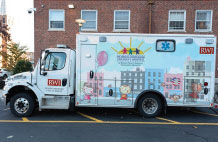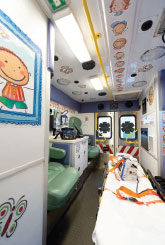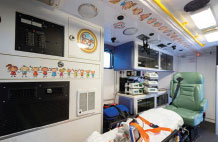Two Custom Ambulances Provide Specialized Treatment and Comfort for Critically Ill Children
 It’s around midnight on a weeknight as an ambulance decorated with pictures of smiling dogs and children pulls up to a New Jersey hospital. Within minutes, a wailing toddler is transported out of the hospital on a stretcher and placed in the ambulance, her worried mother trailing behind her.
It’s around midnight on a weeknight as an ambulance decorated with pictures of smiling dogs and children pulls up to a New Jersey hospital. Within minutes, a wailing toddler is transported out of the hospital on a stretcher and placed in the ambulance, her worried mother trailing behind her.
An Emergency Medical Technician (EMT) gently touches the mother's shoulder.
“Mom, I think it would be better if you sat up front — we’ve found that children this age tend to get more upset if their parents are with them in the back,” he explains.
When the mother hesitates, he leads her toward the back of the ambulance, where the sounds of Elmo singing can be heard.
“See, she’s not even crying — we have the TV on and she’s focused on Elmo,” he reassures her.
The mother smiles and nods, and the rest of the team — composed of a registered nurse, respiratory therapist and physician — climb into the ambulance. The team embarks on their journey to Bristol-Myers Squibb Children’s Hospital (BMSCH) at Robert Wood Johnson University Hospital (RWJUH) New Brunswick, where the toddler will be treated by the pediatric specialty team.

Easing the Fears of Ill Children
While being transported in an ambulance to the hospital is scary for anyone, it’s especially frightening for children. But over the last 10 years, BMSCH at RWJUH has made pediatric patients less anxious with customized pediatric transport ambulances.
Every year, more than 1,000 critically ill children, from newborn to age 21, are transferred from hospitals around the state to BMSCH. Patients range from medically fragile newborns who require immediate, lifesaving surgery and tots nursing a broken bone after a bad tumble to high school students with medical emergencies.
There are two fully equipped pediatric/neonatal transport ambulances, one of which was replaced by a brand-new model in 2019.
“The team is in house 24/7, ready at all times of the day or night, to transport critically ill pediatric patients,” says Sherry L. Calvert, BSN, CCRN, Pediatric Transport Program Manager at BMSCH.
The team of physicians, nurses, respiratory therapists and EMTs that staff the vehicles work throughout BMSCH.
“Some of the team members have worked at BMSCH for well over a decade,” says Calvert. “They are compassionate and highly trained in the care of critically ill pediatric patients. They listen to what parents have to say, realizing that parents know their child best. It’s all about making the experience less stressful for the entire family.”
The newest ambulance was funded by proceeds from the RWJUH Annual Golf Outing, which was held at Metedeconk National Golf Club in June 2018.
The vehicles feature child-friendly designs, such as butterflies, pets and people, as well as a DVD player so kids can watch their favorite videos.

Each vehicle offers pediatric patients access to the capabilities and technologies you’d find in a Pediatric ICU setting — advanced oxygen and air delivery systems, cardiac monitors and defibrillators, ventilators, intravenous catheters, child-sized blood pressure cuffs, syringe pumps that deliver pediatric dosages, specialized equipment for premature infants and a neonatal transport isolette that has been mounted to a stretcher.
Each vehicle’s stretcher is equipped with a portable five-point harness restraint system that serves small patients for safe transport.
There’s also a large cab so a parent can ride to the hospital with his or her child.
Lifesaving Care
The ambulance travels around the state daily picking up kids from local hospitals that don’t have pediatric specialty services to treat them.
“Many hospitals don’t have pediatric orthopedists, for example, so if a child has a broken bone, the physician is not able to set it,” says Calvert.
One ambulance is usually on the road, while the other waits at the hospital for backup.
Calvert has ridden in the ambulance many times herself and has witnessed firsthand the benefits of the vehicle’s specialized care.
Two years ago, she was transporting a 16-year old boy who had an acute change in mental status and was diagnosed with an arteriovenous malformation (abnormal blood vessels) after he stumbled out of his high school locker room confused and disoriented.
He required emergency surgery that was not available at the hospital he was taken to, so he was transferred to BMSCH.
Many weeks later, Calvert assisted in his transfer to Children’s Specialized Hospital for rehabilitation.
“I recently saw him walking into the hospital with his father for a follow-up appointment, and it brought tears to my eyes to see how far he had come,” she recalls. “It’s incredible to know that the care we provided may have meant the difference between life and death for him.”
The 2020 Annual Golf Outing will be held on June 16, 2020 at Montclair Golf Club in West Orange. For more information or to support programs at Robert Wood Johnson University Hospital and The Bristol-Myers Squibb Children’s Hospital, visit RWJUHgiving.org or call (732) 937-8750.